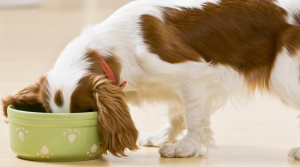
If you’ve been feeding your dog a commercial diet for any length of time, then you’re likely aware of the recalls that happen with too high a frequency. Some recalls are minor and relate more to the people than the dogs, such as when there may be a salmonella contamination with treats or food. Other times the consequences are more severe for our pets, as in past recalls when dogs died from ingesting contaminated food. Even now there is concern about dog treats like chicken turkey produced in China. How can you be sure that your dog’s food is entirely safe and nutritional?
It is possible to cook your dog’s dinner yourself, so long as you know how to create recipes that are nutritional in basis. Without the proper nutrition, your dog’s health will suffer terribly, but if done correctly, he may absolutely thrive.
There are times when a home cooked meal simply works better for a dog. Dogs that are senior may have lost their sense of smell and as a result have a reduced appetite. A warm home cooked meal will do more to activate the receptors in your dog’s nose than a cold bowl of dry kibble. Dogs that are ill often have special requirements for food, and sometimes this involves providing them with a veterinary diet. Unfortunately, not all veterinary diets taste good to a dog, and if you can’t get him to eat it, it’s certainly not beneficial. In these cases, a home cooked meal just tastes better, and with your veterinarian’s help, you can tailor the meal to your dog’s requirements. The picky dog is another prime example. There are some dogs that aren’t fully food motivated or they are just picky. A home cooked meal allows you to get a picky dog to eat better and eat more.
An average dog can also benefit from a non-commercial meal. A home recipe inevitably has more variety than a commercial dog food. It has to have variety to ensure that your dog receives enough nutrients, so he will get a rotation of meats, vegetables, etc. Commercially prepared foods lack any type of variety at all, and it’s possible that after years of consuming a particular item, your dog can develop a food sensitivity or food allergy to an ingredient. This often happens with a protein that is in the food, such as chicken. Additionally, sometimes the average dog appears to have something not-quite-right going on, such as persistent diarrhea, that doesn’t ever get fixed with commercial or veterinary diets and medication. A homemade diet can often correct what is wrong.
The key with any homemade meal is that it has to be nutritionally balanced. This doesn’t require a whole lot of fancy scientific knowledge at all. Instead, it does require you to figure out calories since the caloric content of your meals won’t be printed on the side of a bag. You’ll want to routinely weigh your dog to monitor his weight.
In addition to the actual meal preparation, you’ll need to supplement his dinner with a few key things. The first is a multi-vitamin/mineral supplement. This makes sure that your dog receives full levels of vitamins each day. Ideally he will receive the bulk of his vitamins in his meals, but just like you, the multi-vitamin bridges any gaps in the meals. The second meal supplement is calcium either in bonemeal powder or calcium citrate. This is absolutely necessary when feeding meat in order to avoid a calcium deficiency.
What can go into a meal can be rather basic or more complex, depending on what you want to do and what your dog needs. Proteins should be rotated so that your dog doesn’t eat only chicken (or whichever) at each meal. Other ingredients, such as cooked eggs, also are a good source of protein. Recipes can include a variety of vegetables, such as green beans, carrots, or sweet potatoes, for nutrients and fiber. Recipes can be grain free and utilize more vegetables or can contain small amounts of high quality grains like brown rice or oatmeal.
An excellent resource for learning more about how to prepare your dog’s meal (along with requirements and sample basic recipe) come from the website for Founders Veterinary Clinic and Paula Terifaj, DVM (http://www.foundersvet.com/home_cooking.htm). Look for the daily feeding guideline chart on their website.
Another source of information for cooking meals for your dog is the website for Donald R. Strombeck, DVM, PhD: http://dogcathomeprepareddiet.com/ He was advocating home cooking for dogs for optimum nutrition long before the recalls.
When reviewing or creating recipes for your dog, be sure to be aware of those things your dog should NOT have in his meals. Avoid potential problem ingredients that can be toxic or detrimental to his health. Your dog shouldn’t have onions or grapes, for example. Seeds or leaves of other plants, like apples, can be toxic. You can take a look at various lists to see potential problems or contact the ASPCA for more information (http://www.aspca.org/pet-care/poison-control/people-foods.aspx).
